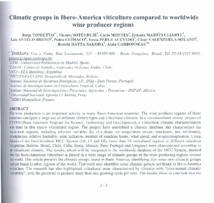Climatic groups in Ibero-Ameríca viticulture compared to worldwide wine producer regions.
Climatic groups in Ibero-Ameríca viticulture compared to worldwide wine producer regions.
Author(s): TONIETTO, J.; RUIZ, V. S.; MONTES, C.; ULLARTE. E. M.; BRUNO, L. A.; CLÍMACO, P.; ACEVEDO, Y. P.; VALENZUELA-SOLANO, C.; SAKODA, B. H.; CARBONNEAU, A.
Summary: Thewine production is an important activity in many Ibero-American countries. The wine producer regions of these countriesconfigure a large use of different c1imate types and viticultural climates. ln a vitivinicultural zoning project of CYTED (Ibero-American Program for Science, Technology and Development), a viticultural c1imatic characterization was done in this macro viticultural region. The project have assembled a climatic database that characterizes the viticultural regions, inc1uding relevant variables for viticulture: air emperature (mean, maximum, and minimum), precipitation, relative humidity, solar radiation, number of sunshine hours, wind speed, and evapotranspiration. Using indicesof the Geoviticulture MCC System (HI, CI and DI), more than 70 viticultura I regions in different countries (Argentina,Bolivia, Brazil, Chile, Cuba, Spain, Mexico, Peru, Portugal and Uruguay) were characterized according to itsviticultural c1imatic. The results, which will be integrated to the worldwide database of the MCC System, showed thatthe Ibero-American viticulture is placed in a wide range of c1imatic groups of the wine producing regions around lheworld. This article presents the c1imatic groups found in Ibero-America, identifying also some new climatic groups notyet found in other regions of the world. This work also identifies some c1imatic groups not found in Ibero-America viticulture.The research has also highlighted viticultural areas characterized by c1imates with "intra-annual c1imatic variability",with the potential to produce more than one growing cyc1e per year. The results allow to conc1ude that the wide variability and climatic diversity present in Ibero-America may be one of the reasons to explain the diversity in terms ofwine types, sensorial characteristics, typicity and uniqueness ofwines produced on this macro-region.
Publication year: 2012
Types of publication: Paper in annals and proceedings
Unit: Embrapa Grape & Wine
Observation
Some of Embrapa's publications are published as ePub files. To read them, use or download one of the following free software options to your computer or mobile device. Android: Google Play Books; IOS: iBooks; Windows and Linux: Calibre.
Access other publications
Access the Agricultural Research Database (BDPA) to consult Embrapa's full library collection and records.
Visit Embrapa Bookstore to purchase books and other publications sold by Embrapa.

